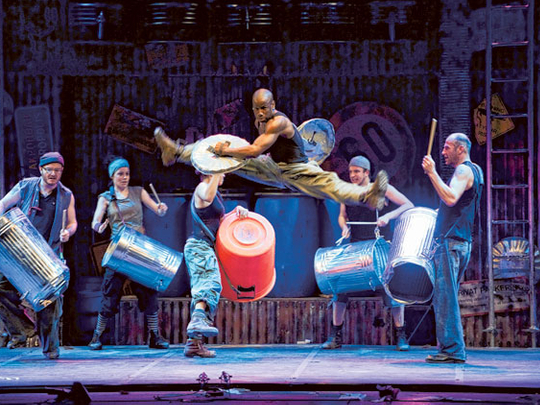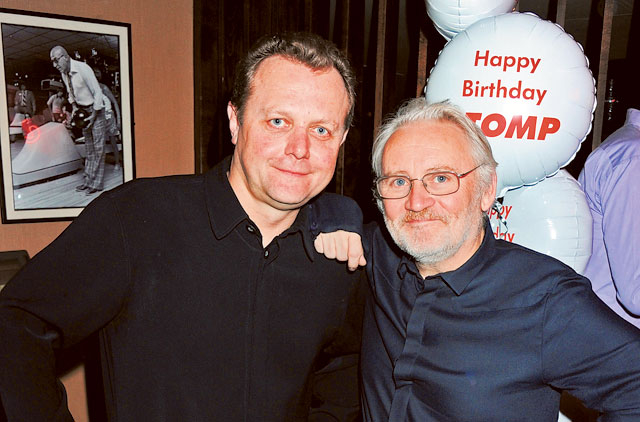
In Brighton, England, in 1991, Steve McNicholas and Luke Cresswall decided to bring the street to the stage.
They were two peas in a pod, fans of everything from the peculiarity of fringe comedy to the brilliant antics of circus acts. Within the thriving world of the UK art scene, they were eager to both consume and produce. They often introduced one another to their favourite shows, songs and troupes, and the two were so like-minded that they even joined forces in a street comedy band named Pookiesnackenburger — a modern-day hipster’s dream.
But something was missing.
“Why isn’t there a show that we really want to see that’s about music and about performance?” McNicholas recalled asking himself back in the day. “And not circus, and not mime, and not African drumming or Japanese drumming, but actually something that’s grown out of our musical experiences?”
Pookisnackenburger eventually gave way to their more evolved band, The Yes/No People. In 1991, a series of shorts were aired on national television featuring them banging on every day objects, like dust bins and bottles, to create distinctive percussive rhythms. Those were the very beginnings of Stomp.
Around 23 years later, it’s a theatrical spectacle known across the world. The show returns to Dubai — it was first in the UAE in 2007 — for five days, from April 30 to May 4 at the Dubai World Trade Centre. For those who have never been, expect no dialogue whatsoever, only swelling music born out of unconventional means, from match sticks and brooms to tyre tubes and shopping carts.
“If you saw the show 20 years ago and you saw it now — in terms of skill, and in terms of complexity, it’s a much, much bigger show. The spirit of what it’s all about is still the same,” McNicholas told tabloid! over the phone from the UK.
McNicholas shared with us what’s changed since they’ve been gone, and why Stomp will likely bang on forever.
What made you decide to bring the show back to this region?
When we created it, we deliberately didn’t have any dialogue in it. We wanted it to be a universal show where there was no barrier to getting into it. At one point, we thought it was going to be more like a concert — there would be spoken introductions to each part — [but then we thought] if we just make the whole thing completely without dialogue, it can travel, it can speak to everybody and anybody.
Right, it’s physical theatre.
There are two languages — we always say there’s only one language, but there’s two, really. There’s the language of rhythm and there’s the body language. What we’ve found is they’re both universal. All music has rhythm. In Stomp, we strip away the things that make it either region-specific or style-specific. You never think, oh, I’m listening to a jazz piece, or a rock piece, or a classical piece. Actually, it’s just a rhythm piece. In terms of the show, we see it as a kind of physical comedy, really. There’s all these different characters on stage, all these elemental personalities. It’s really just about what people are like when they’re put together in a working situation — these little rivalries, little ticks, little messages you give with your body to communicate or to play a game of one-up-manship.
When you talk about Stomp, people often know about the art form but not the story — so what’s the narrative?
In a sense, it’s a musical journey [about] eight people who might be working together in a — it could be anywhere, they could be working together in a factory, or in a garage, or in a scrap yard, it doesn’t really matter — but eight people are brought together and it’s like, ‘well, the things we do every day could be boring or they could be fun.’ It’s really that discovery of that joy of working together — of camaraderie. There’s not a narrative in that one character meets another and falls in love and another one steals their heart. There’s nothing like that. People read that into it.
People take their own meanings from it.
People totally take their own meanings. I don’t mind that. There’s a lot of humour and a lot of physical comedy, but there’s this unwritten rule in Stomp: there’s no negative physical contact. No one will hit anyone. There’s never any demeaning body language. Anything that would appear to be “I’m a macho man” or “you’re a sexy lady” which could be a really easy thing to do, we don’t do anything like that. Because really, it’s just about how we interact when we all have something menial to do, how can we make something menial actually be expressive and exploratory and make music. It’s definitely a deliberate stripping down to basics — it sounds like we’re limiting ourselves, but actually it liberated us.
Why was it important for you to make this show when you did in 1991?
At the time, there wasn’t anything else like Stomp… It was really a case of, ‘Let’s just do it. Let’s just try something and see where it goes.’ It was almost like there was a huge gap in the theatre world that we somehow filled — a piece of a jigsaw puzzle that we found and we fit it in. The impulse was to make a show that we really enjoyed and that we would pay to go see.
Does the show remain very faithful to how it began?
It remains faithful in concept. There are ground rules that we either deliberately laid down in the beginning, or they became unwritten rules that we knew instinctively that we should stick to. But what we do is, every two or three years, we look at the show and say: okay, why don’t we change this? Why don’t we change that? Why don’t we take this piece out? We’ve got an idea for a new piece, let’s put it in. And sometimes we’ll have an idea for a piece that’s been brewing in our minds for years and we haven’t really found a way to make it work and then something clicks — ah, that’s how we do it!
How has the show changed since the last time it was here?
There’s two fairly new pieces in the show. One of them, I don’t know if it was in the show last time — tyre inner tubes. These inner tubes are enormous. You can sit inside of them and you can roll them around. We always wanted to do something with inner tubes, but we didn’t know how to make it work, visually. And suddenly, I saw a guy repairing them [at a tractor repair spot], and he was sitting in the middle of an inner tube, and I suddenly realised what we can do with inner tubes. Within a couple of days, that was in the show. Similarly, we always wanted to do something with supermarket trolleys. We kept playing around with it, and finally, last year, we figured out an approach to it — to play, almost like drum core, in a 5:4 rhythm.
And there are only eight people in the show?
There’s always eight performers on stage, but 12 performers with the company. It’s a really physical, very demanding show; we might do up to eight performances in a week, but we never have people who do all of those shows. What’s nice about that is we have people who can take on different roles, multiple roles, so you could see [Stomp] twice in a week in Dubai and you’d see two different shows. Each performer, whichever role they do, they put themselves into it. When we change what performer plays what role, it really dramatically changes what happens in the show. That was one of the ground rules that we had right from the beginning — we don’t ever clone another performer.
Tickets range between Dh195-Dh595 and are available through virginmegastore.me. Shows are on at 8.30pm with 4.30pm matinee shows on weekends. Contact 050-9652424 for more details.












